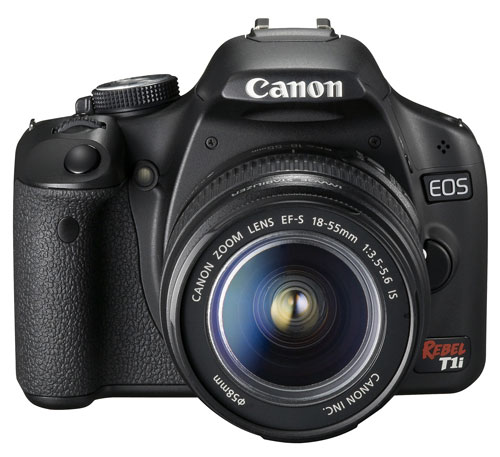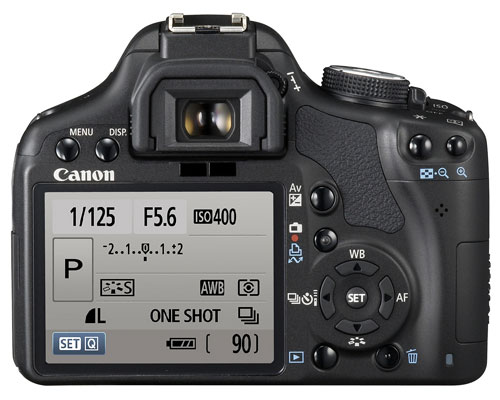Canon Will Soon Ship T1i 15.1 Megapixel HD Video DSLR
by Wesley Fink on April 20, 2009 2:45 PM EST- Posted in
- Digital Camera
The Canon “mainstream” model, currently the Rebel XSi in the USA, is an extremely important camera in the DSLR world. As the world’s most popular DSLR brand, the top-selling Canon is important both to Canon sales, and to the influences it exerts on other manufacturer’s product lines. That is why this important model is often showcased at the biggest photo industry events.
Several weeks ago in late March, with no big event or photo show, Canon announced their replacement to the best-selling XSi. The relative lack of fanfare made many wonder if the new Canon T1i (500D in Europe) was just a lukewarm makeover, but in fact it may be one of the most significant entry mainstream Canons in a very long time.

Outside the new model looks a lot like the current XSi, and it can even use the same BP5 battery grip, but looks can be deciving. Inside the sensor is boosted to 15.1 megapixels, which puts it in the same league as the recent Canon 50D “prosumer” model. The T1i will also be the highest resolution entry model from any camera manufacturer.
Canon also boosts the in-camera image processor to the Digic 4 – which is the same processor used in the 50D and the Canon 5D Mark II full-frame. In a surprise for an entry level model, Canon also brings 14-bit analog to digital processing to the T1i. Up to this time 14-bit-bit processing has only been featured on a few prosumer models and the PRO segment.
With high ISO performance a holy grail in today’s camera market the T1i features a standard ISO range to ISO 6400. That range can be expanded in 2 steps with the H1 option to ISO 6400 and H2 to ISO 12800. This matches the ISO range of the new 50D and is within one stop of the 25600 highest ISO featured on the new full-frame 5D mark II. This represents a real surprise in the entry segment, and is a 3-stop improvement over the ISO 100-1600 range of the current XSi. The AUTO shooting range is also increased to 100-1600 from the very limited 100-400 range of the XSi.

The rear of the camera features a 3” LCD as featured on the XSi, but looks do not tell the whole story. Resolution of the T1i screen is 920,000 dots instead of the 230,000 seen in the XSi model. Again this matches the best 3” screens on more expensive Canon models.
Last, but certainly not least, is the HD video recording capabilities of the T1i. 1080p (1920x1080) can be recorded at 20fps and saved in standard Quicktime MOV (H.264) format. Other video options are 720p (1280x720) at 30fps and standard TV mode (640x480) at 30 fps. The maximum movie file size is 4GB, which means continuous recording is possible up to 12-30 minutes depending on the recording resolution.
The T1i/500D is the second Canon to feature video recording. The new 5D Mark II was the first, and video recording capabilities are similar to the 5D Mark II. This even extends to video recording limited to the Live View function, which limits the cameras AF capabilities in Video recording.
It is difficult to know the fate of a new camera introduction in the midst of a worldwide economic downturn. Certainly the T1i/500D is loaded with all the features that most buyers are looking for these days, and preorders at many dealers are at record levels for the new camera. The market will better tell us whether a new entry model can succeed in today’s difficult economic climate after the early wave of Canon faithful get their new T1i. The new replacement for the XSi is expected to begin shipping in the first half of May.










18 Comments
View All Comments
crb119 - Thursday, September 3, 2009 - link
can some one please post a sample video of about 30seconds or so of the D500 capturing it's 1080p video ..please......this article/review is INCOMPLETTE without that......!!zaphod123 - Wednesday, April 22, 2009 - link
Canon has had 14 bit A/D raw files for a while; the XSI and above all write 14 bit uncompressed CR2 raw files.crb119 - Thursday, September 3, 2009 - link
can some one please post a sample video of about 30seconds or so of the D500 capturing it's 1080p video ..please......this article/review is INCOMPLETTE without that......!!slashbinslashbash - Monday, April 20, 2009 - link
It only seems fair to mention that nobody will actually use the T1i for recording video at 1080x1920 resolution, as it will only capture at 20 frames per second which IMO is not really "1080p" since the 1080p standard only supports as slow as 24fps.araczynski - Tuesday, April 21, 2009 - link
i agree, what's the point of this? to con people into buying them and then pissing them off when they read the fine print?that'll do wonders for brand loyalty.
i think i'll hold out for the successor to this, that does real 1080p.
jpeyton - Tuesday, April 21, 2009 - link
That's exactly the point. Canon's marketing department wanted to put a huge "1080P HD VIDEO!*" sticker on the box, but they also didn't want to give people true 1080p24/30 performance at such a low price, or risk cannibalizing sales from the 60D and 5D Mark II.If you don't care about video, Nikon already leads in absolute image quality for both APS-C and full-frame DSLRs; the D90, D700/D3, and D3x all lead in their respective classes. Because Canon and Nikon alternate product cycles, Nikon's 24MP "budget" full-frame body won't be out until the end of the year, but if you want a preview of what the image quality will be like just read a D3x review.
It's not just a coincidence that the top three full-frame bodies on DxOMark are the D3x, D3, and D700, and the top APS-C body is the D90.
Deadtrees - Tuesday, April 21, 2009 - link
"Nikon already leads in absolute image quality for both APS-C and full-frame DSLRs"I doubt it. I don't know how you define image quality but I find Nikons' gradation to be the worst (Sony being the best until it reaches high ISO,) and their WB is just poor when compared to others. On top of that, there's that nasty gray-cast problem.
dash2k8 - Tuesday, April 21, 2009 - link
"Nikon already leads in absolute image quality for both APS-C and full-frame DSLRs"While Nikon's noise control is better than Canon's without a doubt, "absolute image quality" is just not quantifiable even with benchmarks. In the end, people will buy Canon or Nikon because they are already heavily invested in one system's lenses. I don't understand why there has to be "my brand is better than yours." I used Nikon film bodies and Canon digitals and love both.
Ananke - Tuesday, April 21, 2009 - link
Canon doesn't compete with D90 at this price point, but more like D6o. Also, Canon lenses are less expensive and the excellent 50mm one can be found on deal for 50-80 dollars AND it auto focuses. I think Nikon screw with not having cheap auto focus lenses path in the mid price range.If I have $1200-1500, I would buy Nikon d90. However, for $900 you can get at least similar Canon and buy some really good lenses on the cheap, and auto focus will work.
oldscotch - Saturday, April 25, 2009 - link
Nikon's new 50mm lenses will auto-focuse with all their cameras now.I do agree though, that it does devalue the lower end of NIkon's camera lineup to limit AF funcitonality to lens based AF motors.